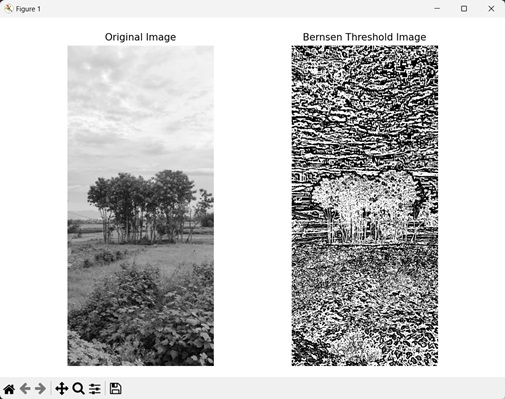
- Mahotas 教程
- Mahotas - 首頁
- Mahotas - 簡介
- Mahotas - 計算機視覺
- Mahotas - 歷史
- Mahotas - 特性
- Mahotas - 安裝
- Mahotas 影像處理
- Mahotas - 影像處理
- Mahotas - 載入影像
- Mahotas - 載入灰度影像
- Mahotas - 顯示影像
- Mahotas - 顯示影像形狀
- Mahotas - 儲存影像
- Mahotas - 影像質心
- Mahotas - 影像卷積
- Mahotas - 建立 RGB 影像
- Mahotas - 影像尤拉數
- Mahotas - 影像中零值的比例
- Mahotas - 獲取影像矩
- Mahotas - 影像區域性最大值
- Mahotas - 影像橢圓軸
- Mahotas - 影像 RGB 拉伸
- Mahotas 顏色空間轉換
- Mahotas - 顏色空間轉換
- Mahotas - RGB 到灰度轉換
- Mahotas - RGB 到 LAB 轉換
- Mahotas - RGB 到 Sepia 轉換
- Mahotas - RGB 到 XYZ 轉換
- Mahotas - XYZ 到 LAB 轉換
- Mahotas - XYZ 到 RGB 轉換
- Mahotas - 增加伽馬校正
- Mahotas - 拉伸伽馬校正
- Mahotas 標記影像函式
- Mahotas - 標記影像函式
- Mahotas - 標記影像
- Mahotas - 過濾區域
- Mahotas - 邊界畫素
- Mahotas - 形態學操作
- Mahotas - 形態學運算元
- Mahotas - 查詢影像平均值
- Mahotas - 裁剪影像
- Mahotas - 影像離心率
- Mahotas - 影像疊加
- Mahotas - 影像圓度
- Mahotas - 調整影像大小
- Mahotas - 影像直方圖
- Mahotas - 影像膨脹
- Mahotas - 影像腐蝕
- Mahotas - 分水嶺演算法
- Mahotas - 影像開運算
- Mahotas - 影像閉運算
- Mahotas - 填充影像孔洞
- Mahotas - 條件膨脹影像
- Mahotas - 條件腐蝕影像
- Mahotas - 影像條件分水嶺演算法
- Mahotas - 影像區域性最小值
- Mahotas - 影像區域最大值
- Mahotas - 影像區域最小值
- Mahotas - 高階概念
- Mahotas - 影像閾值化
- Mahotas - 設定閾值
- Mahotas - 軟閾值
- Mahotas - Bernsen 區域性閾值化
- Mahotas - 小波變換
- 製作影像小波中心
- Mahotas - 距離變換
- Mahotas - 多邊形工具
- Mahotas - 區域性二值模式
- 閾值鄰域統計
- Mahotas - Haralick 特徵
- 標記區域的權重
- Mahotas - Zernike 特徵
- Mahotas - Zernike 矩
- Mahotas - 排序濾波器
- Mahotas - 2D 拉普拉斯濾波器
- Mahotas - 多數濾波器
- Mahotas - 均值濾波器
- Mahotas - 中值濾波器
- Mahotas - Otsu 方法
- Mahotas - 高斯濾波
- Mahotas - 擊中擊不中變換
- Mahotas - 標記最大陣列
- Mahotas - 影像平均值
- Mahotas - SURF 密集點
- Mahotas - SURF 積分
- Mahotas - Haar 變換
- 突出顯示影像最大值
- 計算線性二值模式
- 獲取標籤的邊界
- 反轉 Haar 變換
- Riddler-Calvard 方法
- 標記區域的大小
- Mahotas - 模板匹配
- 加速魯棒特徵
- 刪除帶邊框的標籤
- Mahotas - Daubechies 小波
- Mahotas - Sobel 邊緣檢測
Mahotas - Bernsen 區域性閾值化
Bernsen 區域性閾值化是一種用於將影像分割成前景和背景區域的技術。它利用區域性鄰域的強度變化為影像中的每個畫素分配閾值。
區域性鄰域的大小使用視窗確定。較大的視窗大小在閾值化過程中考慮更多的鄰域畫素,從而在區域之間建立更平滑的過渡,但會去除更精細的細節。
另一方面,較小的視窗大小可以捕獲更多細節,但可能容易受到噪聲的影響。
Bernsen 區域性閾值化與其他閾值化技術的區別在於,Bernsen 區域性閾值化使用動態閾值,而其他閾值化技術使用單個閾值來分離前景和背景區域。
Mahotas 中的 Bernsen 區域性閾值化
在 Mahotas 中,我們可以使用 **thresholding.bernsen()** 和 **thresholding.gbernsen()** 函式將 Bernsen 區域性閾值化應用於影像。這些函式建立一個固定大小的視窗,並計算視窗內每個畫素的區域性對比度範圍以分割影像。
區域性對比度範圍是視窗內的最小和最大灰度值。
然後將閾值計算為最小和最大灰度值的平均值。如果畫素強度高於閾值,則將其分配給前景(白色),否則將其分配給背景(黑色)。
然後視窗在影像上移動以覆蓋所有畫素,以建立二值影像,其中前景和背景區域根據區域性強度變化進行分離。
mahotas.tresholding.bernsen() 函式
mahotas.thresholding.bernsen() 函式以灰度影像作為輸入,並對其應用 Bernsen 區域性閾值化。它輸出一個影像,其中每個畫素被分配 0(黑色)或 255(白色)的值。
前景畫素對應於影像中具有相對較高強度的區域,而背景畫素對應於影像中具有相對較低強度的區域。
語法
以下是 mahotas 中 bernsen() 函式的基本語法:
mahotas.thresholding.bernsen(f, radius, contrast_threshold, gthresh={128})
其中,
**f** - 輸入灰度影像。
**radius** - 每個畫素周圍視窗的大小。
**contrast_threshold** - 區域性閾值。
**gthresh(可選)** - 全域性閾值(預設為 128)。
示例
以下示例顯示了使用 mh.thresholding.bernsen() 函式將 Bernsen 區域性閾值化應用於影像。
import mahotas as mh
import numpy as np
import matplotlib.pyplot as mtplt
# Loading the image
image = mh.imread('nature.jpeg')
# Converting it to grayscale
image = mh.colors.rgb2gray(image)
# Creating Bernsen threshold image
threshold_image = mh.thresholding.bernsen(image, 5, 200)
# Creating a figure and axes for subplots
fig, axes = mtplt.subplots(1, 2)
# Displaying the original image
axes[0].imshow(image, cmap='gray')
axes[0].set_title('Original Image')
axes[0].set_axis_off()
# Displaying the threshold image
axes[1].imshow(threshold_image, cmap='gray')
axes[1].set_title('Bernsen Threshold Image')
axes[1].set_axis_off()
# Adjusting spacing between subplots
mtplt.tight_layout()
# Showing the figures
mtplt.show()
輸出
以下是上述程式碼的輸出:

mahotas.thresholding.gbernsen() 函式
mahotas.thresholding.gbernsen() 函式也對輸入灰度影像應用 Bernsen 區域性閾值化。
它是 Bernsen 區域性閾值化演算法的廣義版本。它輸出一個分割影像,其中每個畫素被分配 0 或 255 的值,具體取決於它是背景還是前景。
gbernsen() 和 bernsen() 函式的區別在於,gbernsen() 函式使用結構元素來定義區域性鄰域,而 bernsen() 函式使用固定大小的視窗來定義畫素周圍的區域性鄰域。
此外,gbernsen() 根據對比度閾值和全域性閾值計算閾值,而 bernsen() 僅使用對比度閾值來計算每個畫素的閾值。
語法
以下是 mahotas 中 gbernsen() 函式的基本語法:
mahotas.thresholding.gbernsen(f, se, contrast_threshold, gthresh)
其中,
**f** - 輸入灰度影像。
**se** - 結構元素。
**contrast_threshold** - 區域性閾值。
**gthresh(可選)** - 全域性閾值。
示例
在這個例子中,我們使用 mh.thresholding.gbernsen() 函式將廣義 Bernsen 區域性閾值化應用於影像。
import mahotas as mh
import numpy as np
import matplotlib.pyplot as mtplt
# Loading the image
image = mh.imread('nature.jpeg')
# Converting it to grayscale
image = mh.colors.rgb2gray(image)
# Creating a structuring element
structuring_element = np.array([[0, 0, 0],[0, 0, 0],[1, 1, 1]])
# Creating generalized Bernsen threshold image
threshold_image = mh.thresholding.gbernsen(image, structuring_element, 200,
128)
# Creating a figure and axes for subplots
fig, axes = mtplt.subplots(1, 2)
# Displaying the original image
axes[0].imshow(image, cmap='gray')
axes[0].set_title('Original Image')
axes[0].set_axis_off()
# Displaying the threshold image
axes[1].imshow(threshold_image, cmap='gray')
axes[1].set_title('Generalized Bernsen Threshold Image')
axes[1].set_axis_off()
# Adjusting spacing between subplots
mtplt.tight_layout()
# Showing the figures
mtplt.show()
輸出
上述程式碼的輸出如下:

使用均值的 Bernsen 區域性閾值化
我們可以使用畫素強度的平均值作為閾值來應用 Bernsen 區域性閾值化。它指的是影像的平均強度,透過將所有畫素的強度值求和,然後除以畫素總數來計算。
在 mahotas 中,我們可以首先使用 numpy.mean() 函式找到所有畫素的平均畫素強度。然後,我們定義一個視窗大小以獲取畫素的區域性鄰域。
最後,我們將平均值設定為閾值,將其傳遞給 bernsen() 或 gbernsen() 函式的 **contrast_threshold** 引數。
示例
這裡,我們正在對影像應用 Bernsen 區域性閾值化,其中閾值是所有畫素強度的平均值。
import mahotas as mh
import numpy as np
import matplotlib.pyplot as mtplt
# Loading the image
image = mh.imread('nature.jpeg')
# Converting it to grayscale
image = mh.colors.rgb2gray(image)
# Calculating mean pixel value
mean = np.mean(image)
# Creating bernsen threshold image
threshold_image = mh.thresholding.bernsen(image, 15, mean)
# Creating a figure and axes for subplots
fig, axes = mtplt.subplots(1, 2)
# Displaying the original image
axes[0].imshow(image, cmap='gray')
axes[0].set_title('Original Image')
axes[0].set_axis_off()
# Displaying the threshold image
axes[1].imshow(threshold_image, cmap='gray')
axes[1].set_title('Bernsen Threshold Image')
axes[1].set_axis_off()
# Adjusting spacing between subplots
mtplt.tight_layout()
# Showing the figures
mtplt.show()
輸出
執行上述程式碼後,我們將獲得以下輸出:
